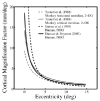Functional and cortical adaptations to central vision loss
- PMID: 15935111
- PMCID: PMC1255967
- DOI: 10.1017/S0952523805222071
Functional and cortical adaptations to central vision loss
Abstract
Age-related macular degeneration (AMD), affecting the retina, afflicts one out of ten people aged 80 years or older in the United States. AMD often results in vision loss to the central 15-20 deg of the visual field (i.e. central scotoma), and frequently afflicts both eyes. In most cases, when the central scotoma includes the fovea, patients will adopt an eccentric preferred retinal locus (PRL) for fixation. The onset of a central scotoma results in the absence of retinal inputs to corresponding regions of retinotopically mapped visual cortex. Animal studies have shown evidence for reorganization in adult mammals for such cortical areas following experimentally induced central scotomata. However, it is still unknown whether reorganization occurs in primary visual cortex (V1) of AMD patients. Nor is it known whether the adoption of a PRL corresponds to changes to the retinotopic mapping of V1. Two recent advances hold out the promise for addressing these issues and for contributing to the rehabilitation of AMD patients: improved methods for assessing visual function across the fields of AMD patients using the scanning laser ophthalmoscope, and the advent of brain-imaging methods for studying retinotopic mapping in humans. For the most part, specialists in these two areas come from different disciplines and communities, with few opportunities to interact. The purpose of this review is to summarize key findings on both the clinical and neuroscience issues related to questions about visual adaptation in AMD patients.
Figures






Similar articles
-
Incomplete cortical reorganization in macular degeneration.Invest Ophthalmol Vis Sci. 2010 Dec;51(12):6826-34. doi: 10.1167/iovs.09-4926. Epub 2010 Jul 14. Invest Ophthalmol Vis Sci. 2010. PMID: 20631240 Free PMC article.
-
Neural and perceptual adaptations in bilateral macular degeneration: an integrative review.Neuropsychologia. 2025 Aug 13;215:109165. doi: 10.1016/j.neuropsychologia.2025.109165. Epub 2025 May 8. Neuropsychologia. 2025. PMID: 40345486 Review.
-
Reorganization of visual processing in age-related macular degeneration depends on foveal loss.Optom Vis Sci. 2014 Aug;91(8):e199-206. doi: 10.1097/OPX.0000000000000325. Optom Vis Sci. 2014. PMID: 24978868 Free PMC article.
-
Functional changes at the preferred retinal locus in subjects with bilateral central vision loss.Graefes Arch Clin Exp Ophthalmol. 2018 Jan;256(1):29-37. doi: 10.1007/s00417-017-3818-3. Epub 2017 Oct 2. Graefes Arch Clin Exp Ophthalmol. 2018. PMID: 28971293
-
Preferred retinal loci and macular scotoma characteristics in patients with age-related macular degeneration.Can J Ophthalmol. 2005 Jun;40(3):303-12. doi: 10.1016/S0008-4182(05)80073-0. Can J Ophthalmol. 2005. PMID: 15947800 Review.
Cited by
-
Multi-line Adaptive Perimetry (MAP): A New Procedure for Quantifying Visual Field Integrity for Rapid Assessment of Macular Diseases.Transl Vis Sci Technol. 2018 Oct 16;7(5):28. doi: 10.1167/tvst.7.5.28. eCollection 2018 Sep. Transl Vis Sci Technol. 2018. PMID: 30356944 Free PMC article.
-
A comparison of reading, in people with simulated and actual central vision loss, with static text, horizontally scrolling text, and rapid serial visual presentation.J Vis. 2021 Nov 1;21(12):5. doi: 10.1167/jov.21.12.5. J Vis. 2021. PMID: 34751737 Free PMC article.
-
Low Vision and Plasticity: Implications for Rehabilitation.Annu Rev Vis Sci. 2016 Oct 14;2:321-343. doi: 10.1146/annurev-vision-111815-114344. Epub 2016 Jul 25. Annu Rev Vis Sci. 2016. PMID: 28532346 Free PMC article. Review.
-
Primary visual cortical remapping in patients with inherited peripheral retinal degeneration.Neuroimage Clin. 2016 Dec 21;13:428-438. doi: 10.1016/j.nicl.2016.12.013. eCollection 2017. Neuroimage Clin. 2016. PMID: 28116235 Free PMC article.
-
The effect of aging on crowded letter recognition in the peripheral visual field.Invest Ophthalmol Vis Sci. 2014 Jul 1;55(8):5039-45. doi: 10.1167/iovs.14-14181. Invest Ophthalmol Vis Sci. 2014. PMID: 24985476 Free PMC article.
References
-
- Akutsu H, Legge GE, Ross JA, Schuebel K. Psychophysics of reading. X. Effects of age-related changes in vision. Journal of Gerontology: Psychological Sciences. 1991;46:325–331. - PubMed
-
- Altpeter E, Mackeben M, Trauzettel-Klosinski S. The importance of sustained attention for patients with maculopathies. Vision Research. 2000;40:1539–1547. - PubMed
-
- Ambati J, Ambati BK, Yoo SH, anchulev S, Adamis AP. Age-related macular degeneration: Etiology, pathogenesis, and therapeutic strategies. Survey of Ophthalmology. 2003;48:257–293. - PubMed
Publication types
MeSH terms
Grants and funding
LinkOut - more resources
Full Text Sources
Medical

